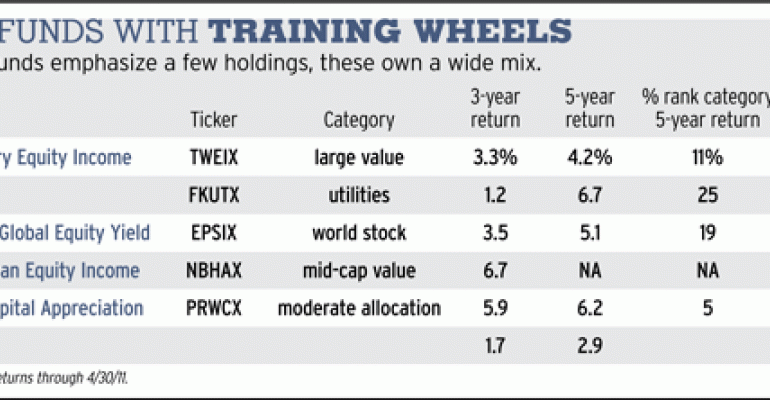Even though the market has been rallying for more than two years, clients remain wary. Many still are clinging to big cash stakes. To calm nerves and ease clients back into stocks, consider using equity funds that rank among the most conservative choices. The steady funds listed below hold some bonds or use other techniques to limit losses in downturns. Think of the cautious performers as equity funds with training wheels.
Make no mistake, the funds do not come with guarantees. All of them lost money in 2008, and many lag in bull markets. Still, conservative funds can help to steady portfolios and deliver solid long-term returns.
Among the safest equity choices is Franklin Utilities (FKUTX). The fund focuses on regulated power producers, companies that typically earn profits in up markets and down. The Franklin approach is very conservative—even compared to the stodgy strategies of competing utilities funds. Besides holding regulated companies, typical utilities funds seek to goose up returns by owning relatively volatile energy and telecom stocks. Franklin steers away from riskier holdings, figuring that shareholders want predictable income from regulated electric producers.
The cautious approach has made Franklin a standout in downturns. “We have had huge outperformance in down years, but we tend to underperform in years when the stock market is doing well,” says portfolio manager John Kohli.
Kohli likes stocks that pay dividends of around 4 percent to 5 percent and can increase earnings by 4 percent to 5 percent annually. A favorite holding is Southern Company, a southeastern utility that yields 4.7 percent and has a long track record of increasing the dividend.
Along with utilities, equity-income funds can be solid choices for nervous investors. The funds typically focus on dividend-paying stocks. The dividend income can stabilize portfolios during hard times. For an unusually low-risk approach, consider Neuberger Berman Equity Income (NBHAX). While typical equity-income funds hold familiar blue chips, the Neuberger portfolio managers diversify more broadly, dividing their assets among four income-oriented holdings: real estate investment trusts (REITs), convertibles, utilities, and other blue-chip dividend payers. As a result of the diversification, the fund delivers a smooth ride.
When the portfolio managers are neutral about the asset classes, they weight each of the four categories equally. The fund currently has only 16% of assets in convertibles and 13 percent in REITs. Both those groups had big rallies as the economy recovered, and now the managers are finding few bargains. The managers have 46 percent of the fund in other dividend stocks, a big overweighting.
The Neuberger managers like stocks with modest prices and solid prospects for increasing earnings and dividends. A favorite holding is Unilever, the giant producer of Wish-Bone salad dressings and Lipton Tea. The stock pays a 4.1 percent dividend, and the company has its sights set on expanding in emerging markets. “Earnings will grow as sales increase in Asia,” says Neuberger portfolio manager Tony Gleason.
Another rock-solid fund is American Century Equity Income (TWEIX), which outpaced 99 percent of its large value competitors in 2008. Portfolio manager Phil Davidson likes blue-chip dividend payers that have fallen out of favor. “We are willing to take slow-moving businesses as long as they have steady profits that can sustain dividends,” he says.
The fund holds stocks in many industries, but it tends to overweight traditional dividend sectors, including telecom, energy, and utilities. A big holding is AT&T, which sells for a price-earnings multiple of 8 and pays a dividend yield of 5.5 percent. The shares have lagged as investors have feared that increasing competition would hurt the company’s cellular business. But Davidson figures that the company will gain market share and continue to cover its dividend.

For extra protection, consider balanced funds, which hold mixes of stocks and bonds. Typical choices cater to conservative investors by putting 60 percent of assets in blue-chip stocks and 40 percent in high-quality bonds. For a contrarian approach, consider T. Rowe Price Capital Appreciation (PRWCX). Portfolio manager David Giroux lowers his equity exposure when stocks look rich. His fixed-income holdings vary, sometimes including convertibles or high-yield securities when they seem cheap.
With stocks and corporate bonds rallying in 2007, Giroux became wary, lowering his equity exposure to 57 percent and putting 10 percent of assets in Treasury bonds. “We added Treasuries when it was not popular to do so,” says Giroux.
The caution helped the fund weather the downturn. Then as stocks sank in second half of 2008, he began bargain shopping, putting 75 percent of assets in equities and scooping up convertibles and high-yield bonds. The strategy enabled the fund to outdo most competitors in 2008 and 2009. Today the fund has turned cautious, lowering the equity exposure to 61 percent.
To hold a mix of foreign and U.S. stocks, consider MainStay Epoch Global Equity Yield (EPSIX). The fund seeks solid stocks that can increase their dividends year after year. Last year, 90 of the fund’s approximately 100 holdings raised their dividends. The increasing dividends provide shareholders with growing income and help cushion the fund during downturns. Portfolio manager Eric Sappenfield says that his foreign holdings help boost the fund’s income. “You can get higher yields and better growth overseas than you can get in the U.S.,” he says.
A favorite holding is Nestle. The food giant has an ironclad balance sheet. Sales should increase steadily as the company expands in emerging markets, Sappenfield says.





